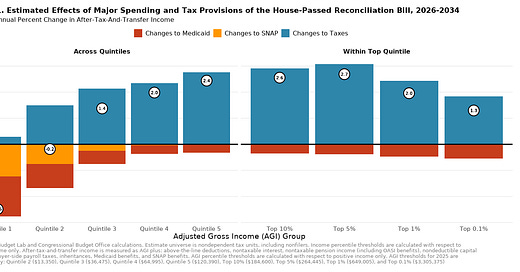Breakfast Bites - Trade talks in focus
OPEC+ meeting this weekend; Revised tax bill passes the senate.
Rise and shine everyone.
US Equities are moving higher again. Yesterday’s speech from Powell seems to have ignited some more positivity. What he exactly said is that the July meeting is live. Had it not been for tariffs, there would’ve been further cuts by now. However, he also noted that the impact of tariffs have not been seen in the inflation numbers yet and it’s quite likely that we will see a few more higher readings during the summer. Still, nothing is off the table for July.
The Trump tax bill narrowly passed the Senate, with Vice President Vance casting the tie-breaking vote. Despite the close call, Republican leaders remain confident the revised bill will win approval in the House tomorrow.
US Equities did see a move lower though, after some rough trade talks surrounding Japan. The Nikkei also slipped again after President Trump raised doubts about a Japan-US trade deal being finalized by the July 9th deadline. He also floated the idea of Japan facing a steep 30–35% tariff, well above the initial 24% rate imposed on “Liberation Day” back in April.
However, the indices later bounced back, trimming most of their losses, as news broke that Japan’s trade representative Akazawa would return to the US for more negotiations over the weekend. Two-year JGB yields also ticked higher in late trading on the headlines.
WTI crude steady ahead of this weekend’s OPEC+ meeting, with markets expecting a further 411K bpd production increase.
In other macro data news, job openings rose in May, defying expectations for a slight drop. Incorporating the latest JOLTS, Indeed, and LinkUp data, the estimated job-worker gap increased to 0.3 million in June, up from 0.2 million in May.
The ISM manufacturing index for June came in slightly above expectations, though the details were mixed—production improved, but new orders and employment declined. The S&P Global manufacturing PMI was revised upward in the final June reading. Meanwhile, construction spending in May fell as anticipated.
In China, the Caixin manufacturing PMI jumped to 50.4 in June from 48.3 in May, surpassing expectations and likely reflecting a delayed impact from the mid-May US-China tariff cut. Output and new orders drove the improvement. While both Caixin and NBS PMIs rose month-over-month, only Caixin moved into expansion territory, highlighting differences in sector focus and survey timing.
Chart of the Day
Yale Budget Lab recently conducted a study on the new tax bill, highlighting its distributional impact across income groups. One important takeaway is how disproportionately it affects low-income earners.
Here are the key findings:
Bottom quintile vs top 1% outcomes: The Senate bill’s tax and spending changes would reduce income for the bottom 20% by approximately 2.9% ($700 annually), while boosting income for the top 1% by about 1.9% ($30,000 annually).
House vs Senate regressivity: Both versions exhibit similar regressivity. The Senate version imposes slightly steeper losses on low-income households (–2.9% vs –2.5%) but offers smaller gains for the top 20% ($5,700 vs $6,500) compared to the House bill.
Trump tariffs could worsen effects: If funded partly by tariffs—as lawmakers have suggested—the combined impact of tariffs, tax, and spending changes would be even more regressive than shown here.
Calendars
(news taken from Reuters, FT, Bloomberg; Calendar from Trading Economics)






